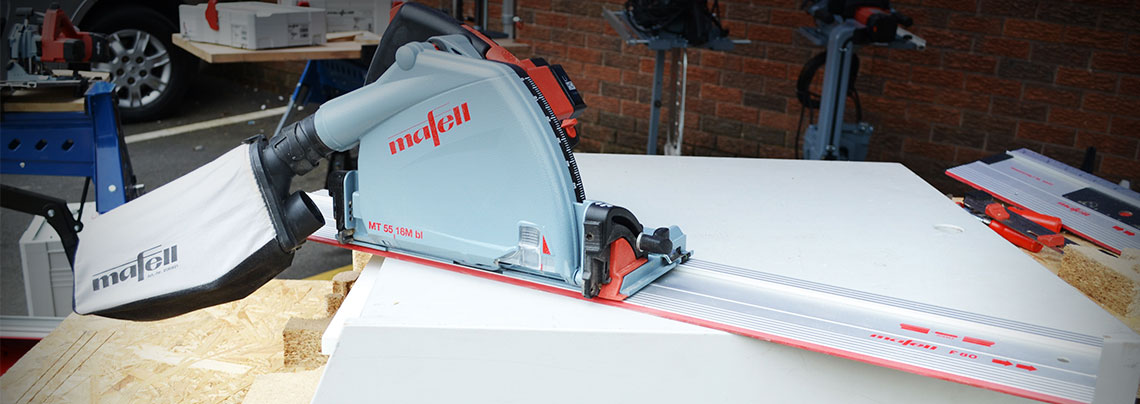Plunge Saw vs Traditional Circular Saw

For many trade professionals we get through our doors, the plunge saw has become a staple power tool for use both in the workshop and on-site. However, we do still get asked “what is the difference between a plunge saw and a circular saw?”, “Plunge Saw vs Traditional Circular Saw, which should I buy?” and “why does the plunge saw cost so much more?” I have written this blog to highlight the fundamental differences between a circular saw and a plunge saw and explain why the plunge saw is often a better option.
Traditional Circular Saw
A conventional circular saw is actually a very basic design consisting of a motor, blade, blade guard and base – to adjust the depth of cut you loosen off a thumb turn nut and set the base to the depth you require to make your cut. As you then cut, the blade guard retracts out of the way, allowing the saw to do its job. The drawbacks to a circular saw however are:
- You need to start your cut at the end of the material you are cutting.
- There is no way of ensuring a splinter-free cut.
- Dust extraction isn’t very efficient due to the blade side being open.
- You cannot guarantee consistent and exact cutting accuracy from a side fence.
Plunge Saw
This is where a plunge saw, or track saw as it’s also known, comes into its own. A plunge saw has a different design which removes the need for a conventional retractable blade guard, as the blade is enclosed within the machine. This ensures multiple benefits versus the traditional circular saw including:
- The blade can be plunged at any point into the material you are cutting.
- An enclosed blade is safer and significantly improves dust extraction efficiency.
- The saw has a smooth and flat side that can be used as a guide against a wall or the floor.
- Depth of cut can also be adjusted with a simple sliding mechanism at the front of the saw.
The biggest and most important difference with the plunge saw however, is the ability to run it along a rail or track. Guide rails can be purchased in many lengths and can even be joined seamlessly together with simple connecting pieces. The underside of the rails have a non-slip material strip to stop the guide from moving or sliding around when in use, ensuring maximum accuracy. Furthermore, there is an option to use ‘rail clamps’ for extra stability and added peace of mind. It doesn’t end there; the rails also have a plastic splinter-guard on the cutting edge to assist when cutting materials that are likely to splinter, such as laminated boards and worktops. If used with the correct and sharp blade, you’ll be left with a finished edge, meaning no need to sand down to a smooth finish. When using a plunge saw with a guide rail, it’s a very simple process… line the rail up with your mark, set your depth, place the saw on the rail, plunge and cut!
I would always recommend using a plunge saw with dust extraction. You will not only save time in getting the job done, but you will also prolong blade and tool life, protect yourself and others from inhaling potentially harmful dust particles along with saving loads of time in cleaning up afterwards.
Where can I get a traditional circular saw and a plunge saw?
Protrade stock two different brands of plunge saws, aimed at the professional and industrial trades. Although similar in design, they have differing innovative features, which I go through in the
See below for more information on the plunge saw range available at Protrade:
Festool
The Festool TS55 is currently one of the biggest selling plunge-cut saws on the market – supplied complete with 2x guide rails, 2 x guide rail connector bars, 2x screw clamps and a guide rail bag.
To watch the video of the Festool TS55 in action: https://youtu.be/XowyQW1lZrA
To buy the Festool TS55FCirculaw Saw click here.
Mafell
The Mafell MT55CC has raised the bar for plunge-cut saws when it comes to performance, finish, accuracy and reliability.
To watch the video of the Mafell MT55CC in action:https://youtu.be/AkFzZkhf2t4
To buy the Mafell MT55CC Plunge Cut Saw click here.
Related Articles
- Festool Saw Blades – Finally a credible alternative to the Festool TS55 Blade for Plunge Saws
- Improve cut accuracy with a guide rail square
- Chop Saw vs Mitre Saw: which one do I need?
- Festool Plunge Saws Review [2021]
- Best Table Saws to Buy in the UK [2022]

Joint Managing Director, Protrade
Craig has over 30 years of experience at Protrade, working in various departments including sales, procurement, and marketing, and ultimately becoming Managing Director in 2008. Following the merger of Protrade and Joinery Fit-Out Supplies in 2018, Craig is now the joint MD of the company.



